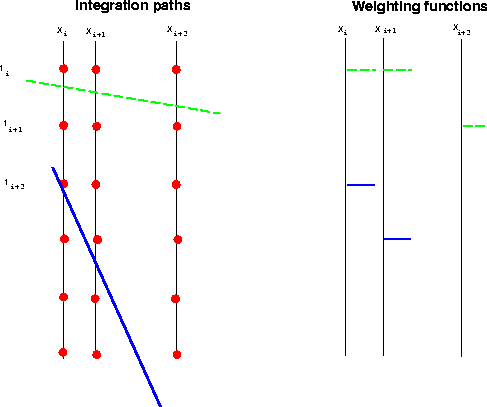




Next: Sampling in time
Up: INTERPOLATION STRATEGIES
Previous: INTERPOLATION STRATEGIES
This is the simplest algorithm and one that is frequently used. At
each trace location the time at which the curve crosses the trace is
calculated. A value for the trace at this time is then added into the
integral. The value may be the value at the nearest time sample, or it
may be a value interpolated from the neighboring time samples.
samp
Figure 3 Sampling in space, a single sample is used at
each space location. The weighting function is a set of impulses, one on each trace. Two trajectories and their corresponding weighting functions are shown. The upper, dashed, trajectory is relatively flat; the lower, solid trajectory is steep.

This method is illustrated in figure ![[*]](http://sepwww.stanford.edu/latex2html/cross_ref_motif.gif) . The sample value at
the trace crossing has been assigned to the region of the curve
between (xix + xix-1)/2 and (xix+1 + xix)/2. Each
trace is sampled at a single location. This approach can lead to
operator aliasing when the dip of the summation trajectory is steep.
The plot on the right of figure
. The sample value at
the trace crossing has been assigned to the region of the curve
between (xix + xix-1)/2 and (xix+1 + xix)/2. Each
trace is sampled at a single location. This approach can lead to
operator aliasing when the dip of the summation trajectory is steep.
The plot on the right of figure ![[*]](http://sepwww.stanford.edu/latex2html/cross_ref_motif.gif) shows a weighting function
for each trace, the integration can be implemented by multiplying each
trace by the weighting function and summing. The weighting function
depends on the sampling between the traces. Since this is a space
integral the weight at the sampled point will be the average distance
to the neighboring traces, i.e. the spatial length of the integration
path for which the sample value is used.
shows a weighting function
for each trace, the integration can be implemented by multiplying each
trace by the weighting function and summing. The weighting function
depends on the sampling between the traces. Since this is a space
integral the weight at the sampled point will be the average distance
to the neighboring traces, i.e. the spatial length of the integration
path for which the sample value is used.





Next: Sampling in time
Up: INTERPOLATION STRATEGIES
Previous: INTERPOLATION STRATEGIES
Stanford Exploration Project
11/17/1997

![[*]](http://sepwww.stanford.edu/latex2html/cross_ref_motif.gif)